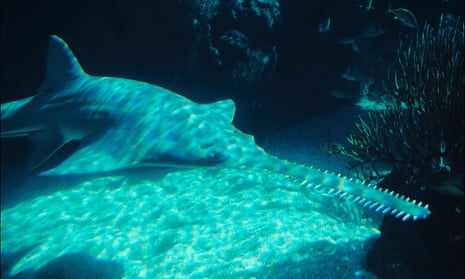Attack on juvenile is thought to be first known time a lone orca has hunted down a great white
It is a smash and grab that has stunned scientists: in less than two minutes, a killer whale attacked and consumed a great white shark before swimming off with the victim’s liver in its mouth.
Experts say the event off the coast of Mossel Bay in South Africa offers new insights into the predatory behaviour of orcas.
While orcas have previously been documented hunting sharks, dolphins and even whales solo, the newly reported event is thought to be the first known time a lone orca has hunted down the world’s largest predatory fish.
“Killer whales, or orcas, usually team up when they hunt, although they can hunt solitarily,” said Dr Alison Towner, of Rhodes University, who led research into the discovery. “The unusual aspect was witnessing Starboard, the killer whale, hunting a white shark alone and in a remarkably rapid timeframe.”
The events, which occurred on 18 June 2023, are documented in the African Journal of Marine Science. It is a sequence that would not be out of place in a Spielberg movie.
The team report how a boat was launched shortly after 2pm in response to sightings of Starboard and another killer whale known as Port. As the vessel crossed the water to follow the pair, the researchers describe how a smell of shark liver and the sight of diving kelp gulls indicated a recent kill.
The subsequent attack was rapid: at 3.02pm a juvenile white shark appeared at the surface of the water. Starboard appeared directly after it.
The whale “gripped the left pectoral fin of the shark and thrust forward with the shark several times before eventually eviscerating it”, the report says. Minutes later Starboard was seen with “a bloody piece of peach-coloured liver in its mouth”.
The attack was also documented by researchers and tourists onboard another vessel that had been involved in shark cage diving activities.
The researchers report that all other recorded events in the region involving orcas preying on sharks involved two to six orcas, and typically took about two hours.
However, while Starboard was able to kill the juvenile great white shark – estimated to have been about 2.5 metres in length and to have weighed about 100kg – alone, the team suggest he may need to cooperate with others to tackle larger prey. Adult great white sharks can grow to 6.5 metres and 2.5 tonnes.
Previous research by the team revealed how Port and Starboard – so-called because their dorsal fins are bent in opposite directions – have been hunting together off the coast of South Africa in recent years.
The pair appear to have a predilection for energy-rich shark livers, although the researchers say it remains unknown how orcas open large sharks to feed on these organs.
Their activities have raised concerns that various shark species, including great white sharks, could be displaced from coastal sites.
Dr Primo Micarelli, a co-author of the new study from the Shark Studies Centre and Siena University, who witnessed the attack by Starboard, said seeing the orca carry the liver of a great white shark past the vessel he was on was unforgettable. But he added: “Despite my awe for these predators, I’m increasingly concerned about the coastal marine ecology balance.”
Guess what you like
Leave a comment
Email addresses will not be published. Required fields are marked with *


